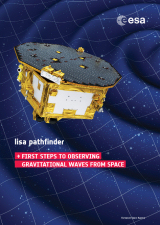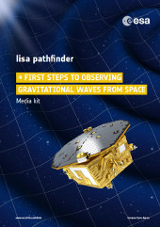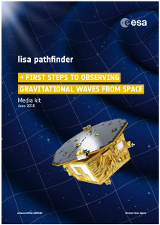ESA Science & Technology - Publication Archive
Publication archive
Publication archive
DOI: https://doi.org/10.1103/PhysRevLett.120.061101
Published by the American Physical Society under the terms of the Creative Commons Attribution 4.0 International license. Further distribution of this work must maintain attribution to the author(s) and the published article's title, journal citation, and DOI.
Published online 7 June 2016
We report the first results of the LISA Pathfinder in-flight experiment. The results demonstrate that two free-falling reference test masses, such as those needed for a space-based gravitational wave observatory like LISA, can be put in free fall with a relative acceleration noise with a square root of the power spectral density of 5.2±0.1 fm s-2/√Hz, or (0.54±0.01)×10-15 g/√Hz, with g the standard gravity, for frequencies between 0.7 and 20 mHz. This value is lower than the LISA Pathfinder requirement by more than a factor 5 and within a factor 1.25 of the requirement for the LISA mission, and is compatible with Brownian noise from viscous damping due to the residual gas surrounding the test masses. Above 60 mHz the acceleration noise is dominated by interferometer displacement readout noise at a level of (34.8±0.3) fm/√Hz, about 2 orders of magnitude better than requirements. At f≤0.5 mHz we observe a low-frequency tail that stays below 12 fm s-2/√Hz down to 0.1 mHz. This performance would allow for a space-based gravitational wave observatory with a sensitivity close to what was originally foreseen for LISA. ![]() This article is available under the terms of the Creative Commons Attribution 3.0 License. Further distribution of this work must maintain attribution to the author(s) and the published article's title, journal citation, and DOI (10.1103/PhysRevLett.116.231101)
This article is available under the terms of the Creative Commons Attribution 3.0 License. Further distribution of this work must maintain attribution to the author(s) and the published article's title, journal citation, and DOI (10.1103/PhysRevLett.116.231101)
This media kit contains background information of use to journalists and reporters covering the LISA Pathfinder mission.
Topics covered:
Why LISA Pathfinder?
Mission at a glance
A challenging build
What LISA Pathfinder is doing and how
Paving the way for gravitational-wave observatories in space
100 years of general relativity
LISA Pathfinder in the context of great physics experiments
Updated in June 2016 to reflect the detection of gravitational waves by the Laser Interferometer Gravitational-Wave Observatory (LIGO) and to account for operational milestones of LISA Pathfinder.
 |
Table of contents:
- A quest for silence
- In the realm of gravity
- The gravitational Universe
- How does it work?
- Building LISA Pathfinder
- Launch
- A physics laboratory in space
- An international enterprise


